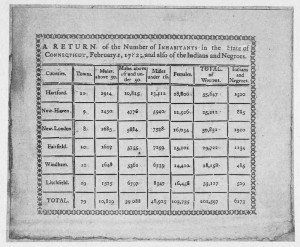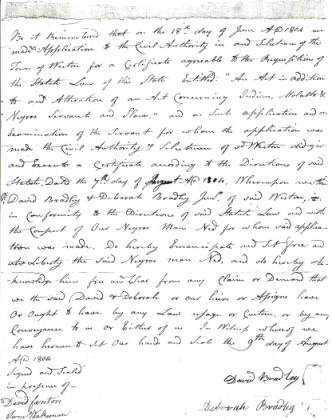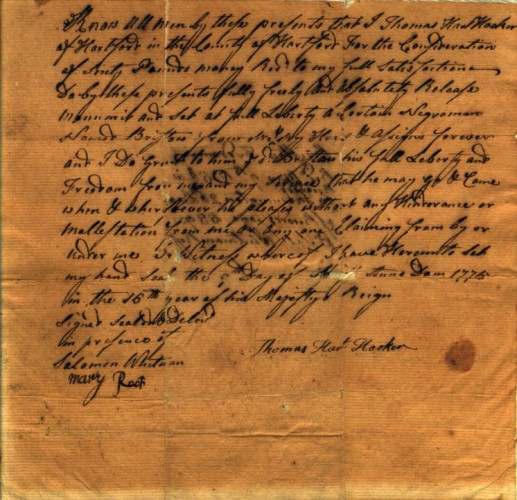By Peter P. Hinks
After the United States gained her independence, the nation struggled with the slavery question. Some northern states abolished the practice altogether, while others opted for gradual emancipation. Connecticut chose the latter course, and although it enacted laws to gradually free individuals held in slavery, it would not be until 1848 that the state completely abolished the practice.
The Revolution Calls Slavery into Question
One of the most important consequences of the American Revolution in the northern states was that they began to take steps to abolish slavery. Neither the Articles of Confederation, which had united the colonies after being issued for ratification in 1777, nor the Constitution, which joined the new states after 1787, gave the national government the power to end slavery in any of the states. Only each state alone could choose to do so.
None of the states from Maryland south chose to end slavery. Moved by the Revolution’s celebration of liberty and the emergence of thousands of newly free blacks who had fought and labored responsibly during the war, states in the North began to act against slavery within their borders.

A return of the number of inhabitants in the State of Connecticut, 1782 – Library of Congress, American Memory
A combination of judicial decisions and constitutional provisions in Massachusetts, New Hampshire, and Vermont hastened the emancipation of slaves, although the actual terms and implementation of abolition did not always prove consistent. In 1780, Pennsylvania passed a gradual emancipation law, and Connecticut and Rhode Island followed suit in 1784. New York and New Jersey, each of which had an enslaved population of well over 10,000 after the Revolution, initially resisted acting against slavery. However, by 1799 in New York and 1804 in New Jersey, gradual emancipation laws had been enacted. By the turn of the 19th century, slavery was well on the road to extinction in the North.
Gradual Emancipation in Connecticut
Gradual emancipation laws leveled a devastating blow to slavery in the North, but they did not abolish slavery. In 1800, Connecticut still had more than 1,000 people held in slavery, a number that would diminish slowly but steadily over the following years. Connecticut’s gradual emancipation act freed children born to enslaved women after March 1, 1784. It did not free the mother, the father, or any other adults. Neither did the children gain their full freedom until they reached, for men, age 25, and for women, age 21.
Prior to those ages, the children remained under the custody of the parents and/or owners and were required to labor as the master directed. The master could also apprentice them to another, or hire them to someone else and keep the proceeds. Thus, prior to attaining their age of majority, these children were legally held in a transitional state between slavery and freedom.
Slaveholders were required, however, to register the birthdates of children born after the March 1, 1784, date and many complied. The children were no longer valued as slave property and were listed as free. Subsequent laws, passed later in the 1780s and 1790s, lowered the age at which the children would be freed and forbade the sale of any of these children or slaves outside of the state.
Philosophies behind the Gradualist Approach
Although some prominent Connecticut individuals, such as the Reverend Jonathan Edwards Jr., Levi Hart, and Theodore Dwight, called for a rapid and total abolition of slavery, most white men who controlled the process of emancipation deemed a gradual end to bondage the most judicious and moral course.
These men included Noah Webster, jurist Zephaniah Smith, and the Reverend James Dana. While they readily acknowledged the injustice and immorality of slavery, they also sought to respect the property rights owners legally held in their slaves and to preserve the stability of the state through a slow and orderly release of the slaves. Part of what made slavery a sin, they argued, was that it damaged the character and the will of the enslaved by subjecting them exclusively to the will of their owners. Thus, they maintained, the enslaved had lost the capacity for responsible self-government and became dependent and depraved. In their view, the hasty release of such people might tear Connecticut’s social fabric without correcting the damage to the enslaved. This approach held that conscientious human government was ordained by God and that society’s leaders must always weigh this against the imperative to end the sin of slavery.
Zephaniah Swift wrote in 1791, “The extinction of slavery [will occur in the United States] . . . as soon as [it] will be compatible with the safety of the public and the welfare of the slaves themselves.” Ideally, honorable white owners and citizens fulfilled their duty to state and to God by preparing the enslaved for freedom through education and catechism and releasing them only in carefully graduated steps. While this gradualism did anticipate an expanding freedom for blacks and their growing independence from whites, the process of that emancipation was to be initiated, structured, and monitored by conscientious whites over the coming years.
African Americans Act to End Slavery

The Emancipation of Ned – Weston Historical Society and the Treasures of Connecticut Libraries
Enslaved African Americans were in no mood to wait for their freedom. Even though no laws existed for the emancipation of enslaved adult, Connecticut had 2,500 free blacks by 1790, the vast majority of whom were born before 1784. By 1800, more than 5,000 free blacks lived in the state. By taking advantage of liberalized manumission laws and negotiating with their owners for a release from bondage or by running away or otherwise seizing freedom, enslaved people had, despite the misgivings of some whites, both the will for independence and the intelligence to secure it.
A smaller number of enslaved individuals, often assisted by white attorneys from the anti-slavery Connecticut Society for the Promotion of Freedom, resorted to the courts to gain their freedom and that of their children and spouses. Slavery, however, would remain present in the state, albeit in ever-dwindling proportions, over the ensuing decades and would not be fully abolished until 1848.
Peter P. Hinks is a historian who has researched and written extensively on slavery and black freedom in Connecticut and the American North.








